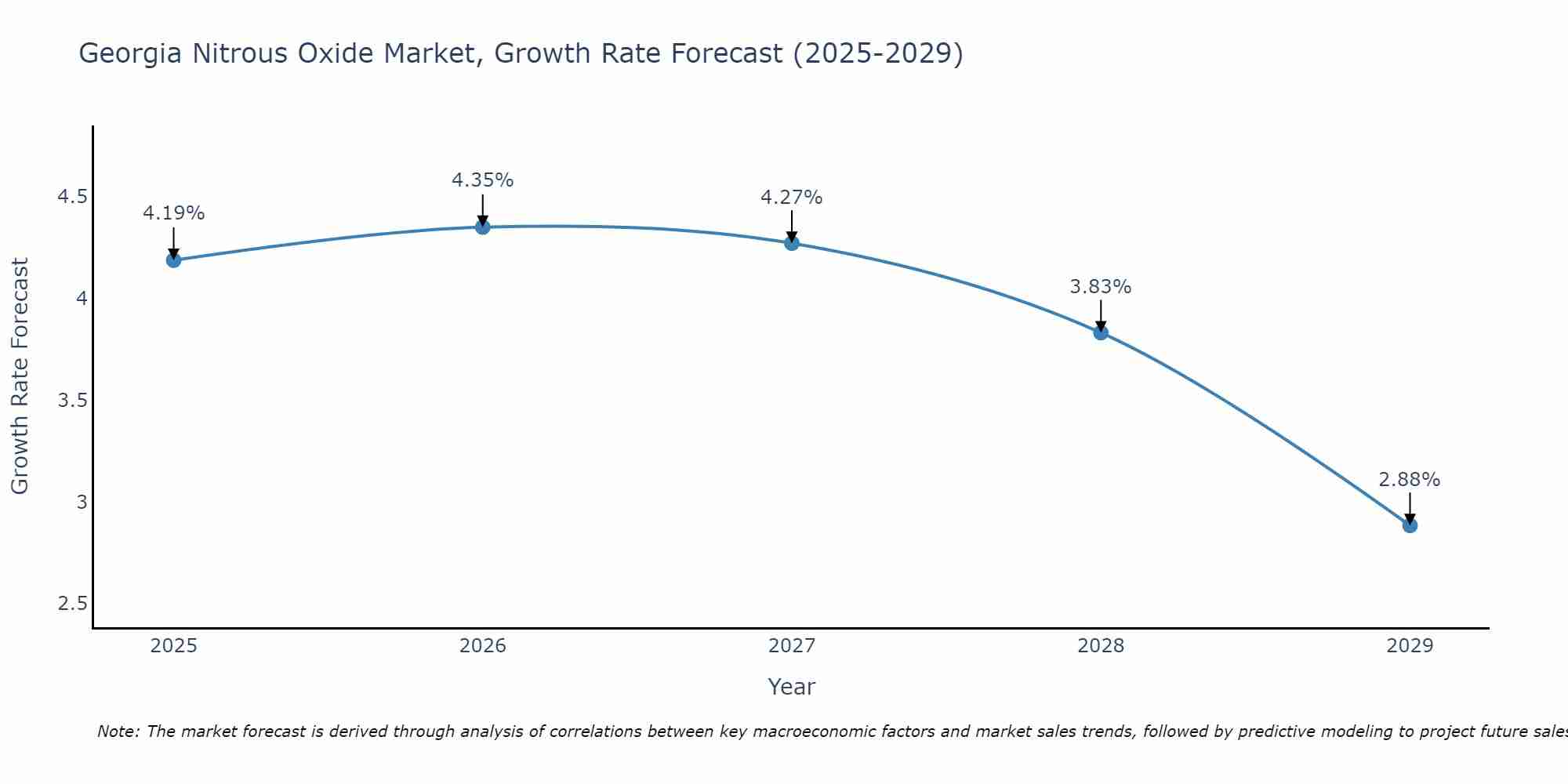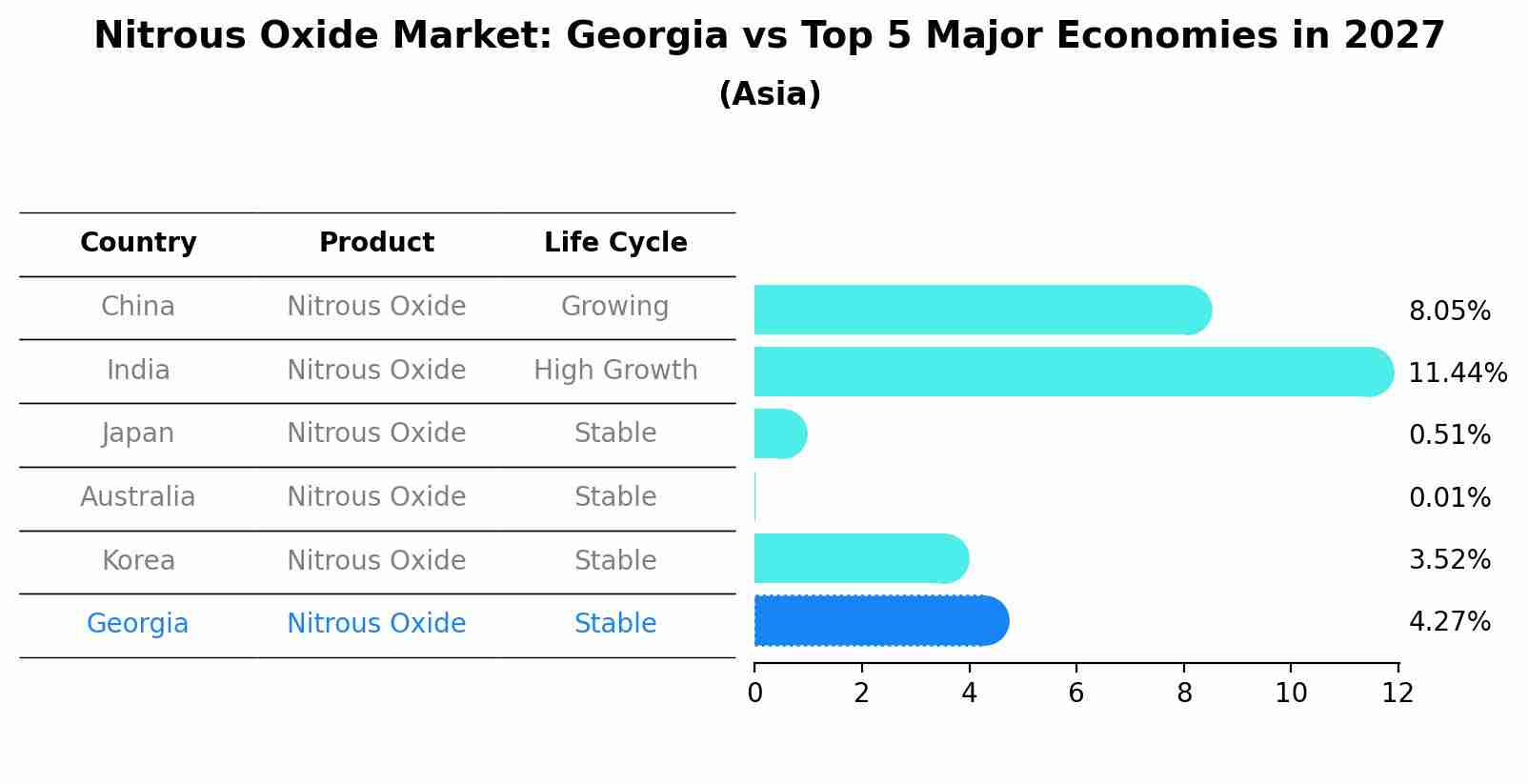Georgia Nitrous Oxide Market (2025-2031) Outlook | Value, Companies, Forecast, Revenue, Share, Trends, Analysis, Size, Growth & Industry
| Product Code: ETC108259 | Publication Date: Jun 2021 | Updated Date: Jun 2025 | Product Type: Report | |
| Publisher: 6Wresearch | Author: Shubham Padhi | No. of Pages: 70 | No. of Figures: 35 | No. of Tables: 5 |
Georgia Nitrous Oxide Market Size Growth Rate
The Georgia Nitrous Oxide Market is projected to witness mixed growth rate patterns during 2025 to 2029. Growth accelerates to 4.35% in 2026, following an initial rate of 4.19%, before easing to 2.88% at the end of the period.

Nitrous Oxide Market: Georgia vs Top 5 Major Economies in 2027 (Asia)
Georgia's Nitrous Oxide market is anticipated to experience a stable growth rate of 4.27% by 2027, reflecting trends observed in the largest economy China, followed by India, Japan, Australia and South Korea.

Georgia Nitrous Oxide Market Overview
The Georgia Nitrous Oxide Market is witnessing steady growth due to increasing demand from various industries such as medical, automotive, and food & beverage. Nitrous oxide, commonly known as laughing gas, is used for its anesthetic and analgesic properties in medical procedures. In the automotive industry, it is used as an oxidizer in racing cars to increase engine performance. Additionally, the food & beverage industry utilizes nitrous oxide for whipped cream dispensers. The market is driven by the growing healthcare sector in Georgia, as well as the increasing popularity of motorsports and culinary arts. Key players operating in the Georgia Nitrous Oxide Market include Georgia Nitrous, Praxair, and Airgas, among others. Ongoing technological advancements and increasing investments in research and development activities are expected to further propel market growth in the coming years.
Georgia Nitrous Oxide Market Trends
The Georgia Nitrous Oxide Market is experiencing a steady growth trend due to the increasing demand from various industries such as healthcare, automotive, and electronics. The healthcare sector, in particular, is driving the market growth with the rising use of nitrous oxide for anesthesia purposes. Additionally, the automotive industry`s focus on reducing emissions is leading to the adoption of nitrous oxide in vehicles for improved engine performance. The electronics industry is also contributing to the market growth with the use of nitrous oxide in semiconductor manufacturing processes. Overall, the Georgia Nitrous Oxide Market is expected to continue its growth trajectory in the coming years as these industries expand and innovate their applications of nitrous oxide.
Georgia Nitrous Oxide Market Challenges
In the Georgia nitrous oxide market, some key challenges include regulatory restrictions on the use and distribution of nitrous oxide due to its potential for misuse as a recreational drug, which can impact legitimate medical and industrial uses. Additionally, fluctuating prices of raw materials and transportation costs can affect the overall cost structure for nitrous oxide suppliers and distributors. Competition from alternative gases and technologies also poses a challenge, as customers may seek more cost-effective or environmentally friendly options. Furthermore, ensuring compliance with safety standards and regulations related to handling and storage of nitrous oxide is crucial to prevent accidents and maintain a safe working environment. Overall, navigating these challenges requires a strategic approach and continuous monitoring of market dynamics in the Georgia nitrous oxide industry.
Georgia Nitrous Oxide Market Investment Opportunities
The Georgia Nitrous Oxide Market presents potential investment opportunities in various sectors. One option is to invest in companies involved in the manufacturing and distribution of nitrous oxide for medical and industrial purposes. With the growing demand for nitrous oxide in healthcare, including anesthesia and respiratory therapies, investing in companies that supply to hospitals and medical facilities could be lucrative. Another opportunity lies in the food and beverage industry, where nitrous oxide is used as a propellant in whipped cream dispensers. Additionally, considering the increasing awareness of environmental sustainability, investing in companies developing nitrous oxide emission reduction technologies could prove to be a wise decision. Overall, the Georgia Nitrous Oxide Market offers diverse investment prospects across different sectors, providing investors with options to capitalize on the market`s growth potential.
Georgia Nitrous Oxide Market Government Policy
Government policies related to the Georgia Nitrous Oxide Market focus on regulating the production, distribution, and use of nitrous oxide to ensure environmental protection and public safety. The Georgia Environmental Protection Division (EPD) oversees the implementation of regulations governing the emissions of nitrous oxide from industrial sources, such as power plants and manufacturing facilities. Additionally, there are regulations in place to control the sale and use of nitrous oxide for recreational purposes, particularly in the form of "whippits" or nitrous oxide cartridges used for inhalation. The government aims to minimize the impact of nitrous oxide on air quality and human health by enforcing strict emissions standards and monitoring the supply chain of nitrous oxide in the state.
Georgia Nitrous Oxide Market Future Outlook
The Georgia Nitrous Oxide Market is expected to witness steady growth in the coming years, driven by increasing demand from various end-use industries such as healthcare, automotive, and electronics. The rising prevalence of chronic diseases requiring anesthesia procedures, coupled with the expanding automotive sector in the region, is anticipated to fuel the market growth. Additionally, the growing adoption of nitrous oxide for various industrial applications, such as semiconductor manufacturing and food processing, is likely to contribute to market expansion. However, stringent regulations regarding the use and handling of nitrous oxide may pose challenges for market players. Overall, with the continuous technological advancements and increasing applications of nitrous oxide, the market in Georgia is poised for a positive outlook in the foreseeable future.
Key Highlights of the Report:
- Georgia Nitrous Oxide Market Outlook
- Market Size of Georgia Nitrous Oxide Market, 2021
- Forecast of Georgia Nitrous Oxide Market, 2031
- Historical Data and Forecast of Georgia Nitrous Oxide Revenues & Volume for the Period 2021 - 2031
- Georgia Nitrous Oxide Market Trend Evolution
- Georgia Nitrous Oxide Market Drivers and Challenges
- Georgia Nitrous Oxide Price Trends
- Georgia Nitrous Oxide Porter's Five Forces
- Georgia Nitrous Oxide Industry Life Cycle
- Historical Data and Forecast of Georgia Nitrous Oxide Market Revenues & Volume By Applications for the Period 2021 - 2031
- Historical Data and Forecast of Georgia Nitrous Oxide Market Revenues & Volume By Automotive for the Period 2021 - 2031
- Historical Data and Forecast of Georgia Nitrous Oxide Market Revenues & Volume By Medical for the Period 2021 - 2031
- Historical Data and Forecast of Georgia Nitrous Oxide Market Revenues & Volume By Electronics for the Period 2021 - 2031
- Historical Data and Forecast of Georgia Nitrous Oxide Market Revenues & Volume By Food & Beverage for the Period 2021 - 2031
- Historical Data and Forecast of Georgia Nitrous Oxide Market Revenues & Volume By Others for the Period 2021 - 2031
- Georgia Nitrous Oxide Import Export Trade Statistics
- Market Opportunity Assessment By Applications
- Georgia Nitrous Oxide Top Companies Market Share
- Georgia Nitrous Oxide Competitive Benchmarking By Technical and Operational Parameters
- Georgia Nitrous Oxide Company Profiles
- Georgia Nitrous Oxide Key Strategic Recommendations
Frequently Asked Questions About the Market Study (FAQs):
1 Executive Summary |
2 Introduction |
2.1 Key Highlights of the Report |
2.2 Report Description |
2.3 Market Scope & Segmentation |
2.4 Research Methodology |
2.5 Assumptions |
3 Georgia Nitrous Oxide Market Overview |
3.1 Georgia Country Macro Economic Indicators |
3.2 Georgia Nitrous Oxide Market Revenues & Volume, 2021 & 2031F |
3.3 Georgia Nitrous Oxide Market - Industry Life Cycle |
3.4 Georgia Nitrous Oxide Market - Porter's Five Forces |
3.5 Georgia Nitrous Oxide Market Revenues & Volume Share, By Applications, 2021 & 2031F |
4 Georgia Nitrous Oxide Market Dynamics |
4.1 Impact Analysis |
4.2 Market Drivers |
4.3 Market Restraints |
5 Georgia Nitrous Oxide Market Trends |
6 Georgia Nitrous Oxide Market, By Types |
6.1 Georgia Nitrous Oxide Market, By Applications |
6.1.1 Overview and Analysis |
6.1.2 Georgia Nitrous Oxide Market Revenues & Volume, By Applications, 2018 - 2027F |
6.1.3 Georgia Nitrous Oxide Market Revenues & Volume, By Automotive, 2018 - 2027F |
6.1.4 Georgia Nitrous Oxide Market Revenues & Volume, By Medical, 2018 - 2027F |
6.1.5 Georgia Nitrous Oxide Market Revenues & Volume, By Electronics, 2018 - 2027F |
6.1.6 Georgia Nitrous Oxide Market Revenues & Volume, By Food & Beverage, 2018 - 2027F |
6.1.7 Georgia Nitrous Oxide Market Revenues & Volume, By Others, 2018 - 2027F |
7 Georgia Nitrous Oxide Market Import-Export Trade Statistics |
7.1 Georgia Nitrous Oxide Market Export to Major Countries |
7.2 Georgia Nitrous Oxide Market Imports from Major Countries |
8 Georgia Nitrous Oxide Market Key Performance Indicators |
9 Georgia Nitrous Oxide Market - Opportunity Assessment |
9.1 Georgia Nitrous Oxide Market Opportunity Assessment, By Applications, 2021 & 2031F |
10 Georgia Nitrous Oxide Market - Competitive Landscape |
10.1 Georgia Nitrous Oxide Market Revenue Share, By Companies, 2021 |
10.2 Georgia Nitrous Oxide Market Competitive Benchmarking, By Operating and Technical Parameters |
11 Company Profiles |
12 Recommendations |
13 Disclaimer |
- Single User License$ 1,995
- Department License$ 2,400
- Site License$ 3,120
- Global License$ 3,795
Search
Related Reports
- Portugal Electronic Document Management Market (2025-2031) | Strategy, Consumer Insights, Analysis, Investment Trends, Opportunities, Growth, Size, Share, Industry, Revenue, Segments, Value, Segmentation, Supply, Forecast, Restraints, Outlook, Competition, Drivers, Trends, Demand, Pricing Analysis, Competitive, Strategic Insights, Companies, Challenges
- France Electronic Document Management Market (2025-2031) | Strategy, Consumer Insights, Analysis, Investment Trends, Opportunities, Growth, Size, Share, Industry, Revenue, Segments, Value, Segmentation, Supply, Forecast, Restraints, Outlook, Competition, Drivers, Trends, Demand, Pricing Analysis, Competitive, Strategic Insights, Companies, Challenges
- Portugal Occupational Health & Safety Services Market (2025-2031) | Strategy, Consumer Insights, Analysis, Investment Trends, Opportunities, Growth, Size, Share, Industry, Revenue, Segments, Value, Segmentation, Supply, Forecast, Restraints, Outlook, Competition, Drivers, Trends, Demand, Pricing Analysis, Competitive, Strategic Insights, Companies, Challenges
- Netherlands Occupational Health and Safety Services Market (2025-2031) | Strategy, Consumer Insights, Analysis, Investment Trends, Opportunities, Growth, Size, Share, Industry, Revenue, Segments, Value, Segmentation, Supply, Forecast, Restraints, Outlook, Competition, Drivers, Trends, Demand, Pricing Analysis, Competitive, Strategic Insights, Companies, Challenges
- Belgium and Luxembourg Facility Management Market (2025-2031) | Strategy, Consumer Insights, Analysis, Investment Trends, Opportunities, Growth, Size, Share, Industry, Revenue, Segments, Value, Segmentation, Supply, Forecast, Restraints, Outlook, Competition, Drivers, Trends, Demand, Pricing Analysis, Competitive, Strategic Insights, Companies, Challenges
- Russia Women Intimate Apparel Market (2025-2031) | Strategy, Consumer Insights, Analysis, Investment Trends, Opportunities, Growth, Size, Share, Industry, Revenue, Segments, Value, Segmentation, Supply, Forecast, Restraints, Outlook, Competition, Drivers, Trends, Demand, Pricing Analysis, Competitive, Strategic Insights, Companies, Challenges
- Africa Chocolate Market (2025-2031) | Size, Share, Trends, Growth, Revenue, Analysis, Forecast, industry & Outlook
- Global Hydroxychloroquine And Chloroquine Market (2025-2031) | Industry, Trends, Size, Outlook, Growth, Value, Companies, Revenue, Analysis, Share, Forecast
- Saudi Arabia Plant Maintenance Market (2025-2031) | Industry, Size, Growth, Revenue, Value, Companies, Forecast, Analysis, Share & Trends
- Taiwan Electric Truck Market (2025-2031) | Outlook, Industry, Revenue, Size, Forecast, Growth, Analysis, Share, Companies, Value & Trends
Industry Events and Analyst Meet
Our Clients
Whitepaper
- Middle East & Africa Commercial Security Market Click here to view more.
- Middle East & Africa Fire Safety Systems & Equipment Market Click here to view more.
- GCC Drone Market Click here to view more.
- Middle East Lighting Fixture Market Click here to view more.
- GCC Physical & Perimeter Security Market Click here to view more.
6WResearch In News
- Doha a strategic location for EV manufacturing hub: IPA Qatar
- Demand for luxury TVs surging in the GCC, says Samsung
- Empowering Growth: The Thriving Journey of Bangladesh’s Cable Industry
- Demand for luxury TVs surging in the GCC, says Samsung
- Video call with a traditional healer? Once unthinkable, it’s now common in South Africa
- Intelligent Buildings To Smooth GCC’s Path To Net Zero













